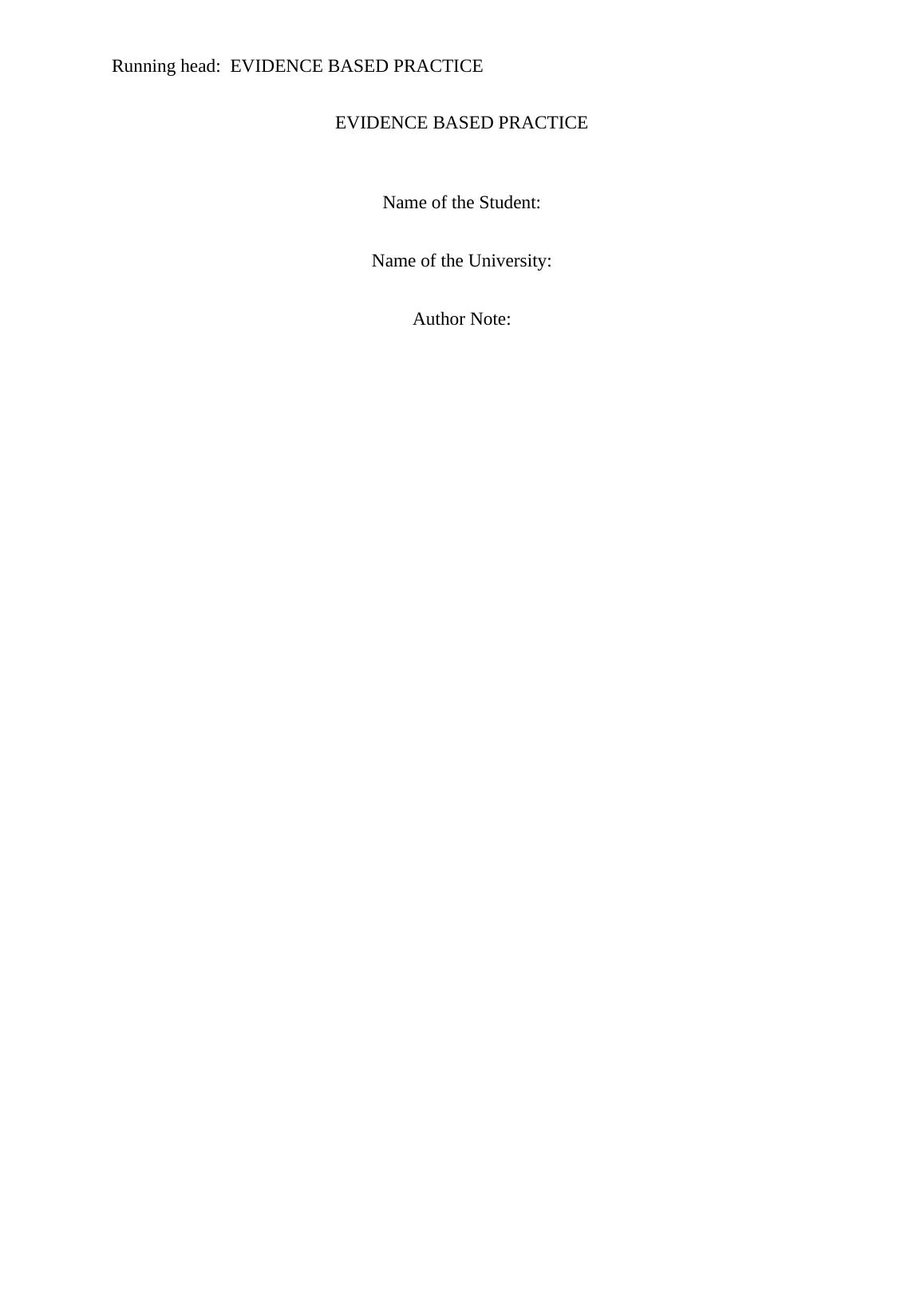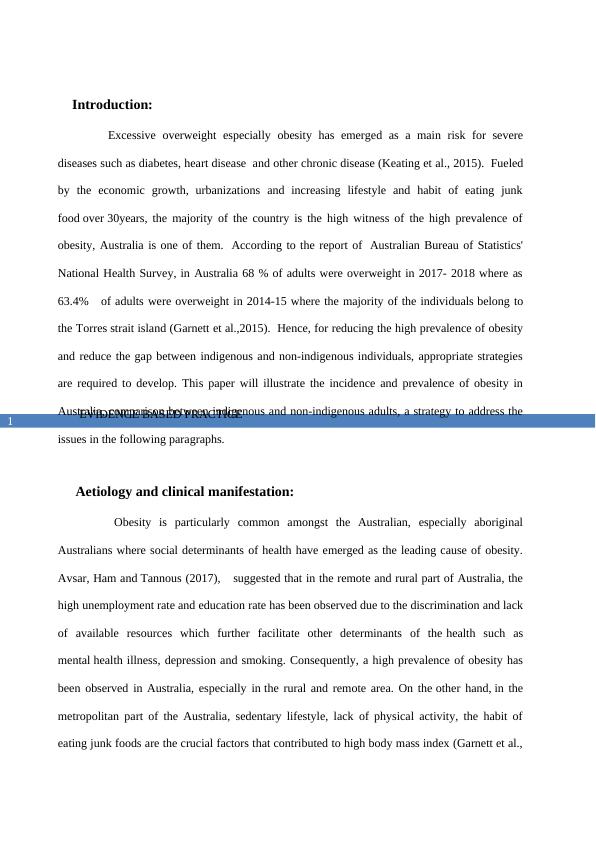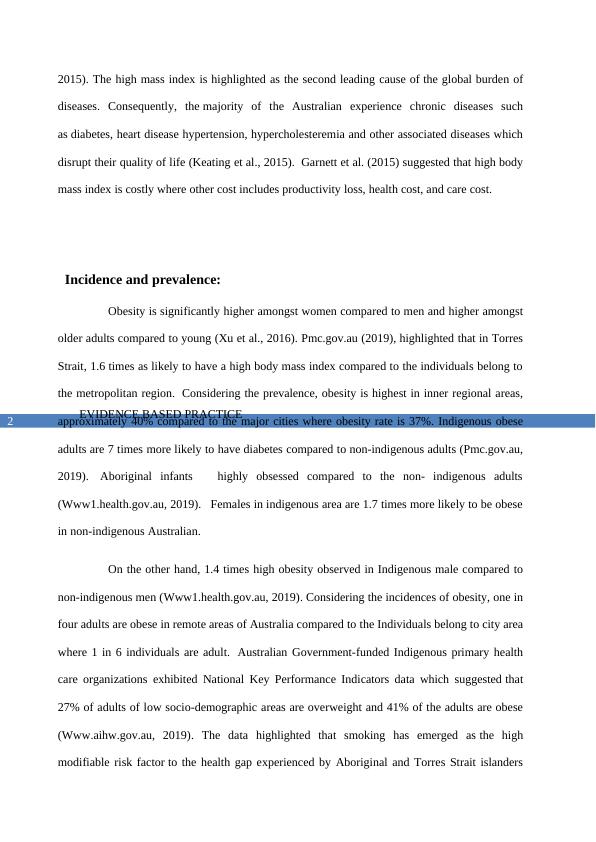Evidence Based Practice Assignment 2022
Added on 2022-10-07
7 Pages1760 Words27 Views
Running head: EVIDENCE BASED PRACTICE
EVIDENCE BASED PRACTICE
Name of the Student:
Name of the University:
Author Note:
EVIDENCE BASED PRACTICE
Name of the Student:
Name of the University:
Author Note:

EVIDENCE BASED PRACTICE
1
Introduction:
Excessive overweight especially obesity has emerged as a main risk for severe
diseases such as diabetes, heart disease and other chronic disease (Keating et al., 2015). Fueled
by the economic growth, urbanizations and increasing lifestyle and habit of eating junk
food over 30years, the majority of the country is the high witness of the high prevalence of
obesity, Australia is one of them. According to the report of Australian Bureau of Statistics'
National Health Survey, in Australia 68 % of adults were overweight in 2017- 2018 where as
63.4% of adults were overweight in 2014-15 where the majority of the individuals belong to
the Torres strait island (Garnett et al.,2015). Hence, for reducing the high prevalence of obesity
and reduce the gap between indigenous and non-indigenous individuals, appropriate strategies
are required to develop. This paper will illustrate the incidence and prevalence of obesity in
Australia, comparison between indigenous and non-indigenous adults, a strategy to address the
issues in the following paragraphs.
Aetiology and clinical manifestation:
Obesity is particularly common amongst the Australian, especially aboriginal
Australians where social determinants of health have emerged as the leading cause of obesity.
Avsar, Ham and Tannous (2017), suggested that in the remote and rural part of Australia, the
high unemployment rate and education rate has been observed due to the discrimination and lack
of available resources which further facilitate other determinants of the health such as
mental health illness, depression and smoking. Consequently, a high prevalence of obesity has
been observed in Australia, especially in the rural and remote area. On the other hand, in the
metropolitan part of the Australia, sedentary lifestyle, lack of physical activity, the habit of
eating junk foods are the crucial factors that contributed to high body mass index (Garnett et al.,
1
Introduction:
Excessive overweight especially obesity has emerged as a main risk for severe
diseases such as diabetes, heart disease and other chronic disease (Keating et al., 2015). Fueled
by the economic growth, urbanizations and increasing lifestyle and habit of eating junk
food over 30years, the majority of the country is the high witness of the high prevalence of
obesity, Australia is one of them. According to the report of Australian Bureau of Statistics'
National Health Survey, in Australia 68 % of adults were overweight in 2017- 2018 where as
63.4% of adults were overweight in 2014-15 where the majority of the individuals belong to
the Torres strait island (Garnett et al.,2015). Hence, for reducing the high prevalence of obesity
and reduce the gap between indigenous and non-indigenous individuals, appropriate strategies
are required to develop. This paper will illustrate the incidence and prevalence of obesity in
Australia, comparison between indigenous and non-indigenous adults, a strategy to address the
issues in the following paragraphs.
Aetiology and clinical manifestation:
Obesity is particularly common amongst the Australian, especially aboriginal
Australians where social determinants of health have emerged as the leading cause of obesity.
Avsar, Ham and Tannous (2017), suggested that in the remote and rural part of Australia, the
high unemployment rate and education rate has been observed due to the discrimination and lack
of available resources which further facilitate other determinants of the health such as
mental health illness, depression and smoking. Consequently, a high prevalence of obesity has
been observed in Australia, especially in the rural and remote area. On the other hand, in the
metropolitan part of the Australia, sedentary lifestyle, lack of physical activity, the habit of
eating junk foods are the crucial factors that contributed to high body mass index (Garnett et al.,

EVIDENCE BASED PRACTICE
2
2015). The high mass index is highlighted as the second leading cause of the global burden of
diseases. Consequently, the majority of the Australian experience chronic diseases such
as diabetes, heart disease hypertension, hypercholesteremia and other associated diseases which
disrupt their quality of life (Keating et al., 2015). Garnett et al. (2015) suggested that high body
mass index is costly where other cost includes productivity loss, health cost, and care cost.
Incidence and prevalence:
Obesity is significantly higher amongst women compared to men and higher amongst
older adults compared to young (Xu et al., 2016). Pmc.gov.au (2019), highlighted that in Torres
Strait, 1.6 times as likely to have a high body mass index compared to the individuals belong to
the metropolitan region. Considering the prevalence, obesity is highest in inner regional areas,
approximately 40% compared to the major cities where obesity rate is 37%. Indigenous obese
adults are 7 times more likely to have diabetes compared to non-indigenous adults (Pmc.gov.au,
2019). Aboriginal infants highly obsessed compared to the non- indigenous adults
(Www1.health.gov.au, 2019). Females in indigenous area are 1.7 times more likely to be obese
in non-indigenous Australian.
On the other hand, 1.4 times high obesity observed in Indigenous male compared to
non-indigenous men (Www1.health.gov.au, 2019). Considering the incidences of obesity, one in
four adults are obese in remote areas of Australia compared to the Individuals belong to city area
where 1 in 6 individuals are adult. Australian Government-funded Indigenous primary health
care organizations exhibited National Key Performance Indicators data which suggested that
27% of adults of low socio-demographic areas are overweight and 41% of the adults are obese
(Www.aihw.gov.au, 2019). The data highlighted that smoking has emerged as the high
modifiable risk factor to the health gap experienced by Aboriginal and Torres Strait islanders
2
2015). The high mass index is highlighted as the second leading cause of the global burden of
diseases. Consequently, the majority of the Australian experience chronic diseases such
as diabetes, heart disease hypertension, hypercholesteremia and other associated diseases which
disrupt their quality of life (Keating et al., 2015). Garnett et al. (2015) suggested that high body
mass index is costly where other cost includes productivity loss, health cost, and care cost.
Incidence and prevalence:
Obesity is significantly higher amongst women compared to men and higher amongst
older adults compared to young (Xu et al., 2016). Pmc.gov.au (2019), highlighted that in Torres
Strait, 1.6 times as likely to have a high body mass index compared to the individuals belong to
the metropolitan region. Considering the prevalence, obesity is highest in inner regional areas,
approximately 40% compared to the major cities where obesity rate is 37%. Indigenous obese
adults are 7 times more likely to have diabetes compared to non-indigenous adults (Pmc.gov.au,
2019). Aboriginal infants highly obsessed compared to the non- indigenous adults
(Www1.health.gov.au, 2019). Females in indigenous area are 1.7 times more likely to be obese
in non-indigenous Australian.
On the other hand, 1.4 times high obesity observed in Indigenous male compared to
non-indigenous men (Www1.health.gov.au, 2019). Considering the incidences of obesity, one in
four adults are obese in remote areas of Australia compared to the Individuals belong to city area
where 1 in 6 individuals are adult. Australian Government-funded Indigenous primary health
care organizations exhibited National Key Performance Indicators data which suggested that
27% of adults of low socio-demographic areas are overweight and 41% of the adults are obese
(Www.aihw.gov.au, 2019). The data highlighted that smoking has emerged as the high
modifiable risk factor to the health gap experienced by Aboriginal and Torres Strait islanders

End of preview
Want to access all the pages? Upload your documents or become a member.
Related Documents
Health and Wellbeing - PDFlg...
|16
|3407
|75
First People Health in Australia Assignment 2022lg...
|9
|3903
|15
Obesity in Australialg...
|9
|1996
|210
Program Development Intelligence Reportlg...
|19
|5154
|27
Obesity and Social Issues among the Aboriginalslg...
|7
|1720
|89
NUTD 9226: Public Health and Community Nutritionlg...
|28
|7044
|85
